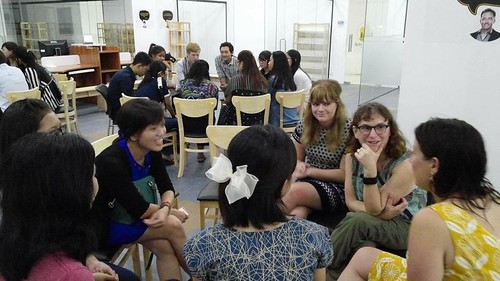
Note from Beth: As a trainer and someone who teachers other trainers, I’ve been obsessed with improving my facilitation skills and written a lot about it on this blog. I’m always up for a conversation with other facilitators about shop talk and getting tips for improving my practice. So, I’m thrilled that fellow facilitators Cody Sigel, MPH, CHES and Tracy Wright, MAED from ETR agreed to share some of their secrets in this guest post.
7 Tips to Make You A Stronger Facilitator
The first time you facilitate a training, you start developing your own personal list of tips for great facilitation. You try out some things that work, and they go on your list (“I can’t wait to try that again!”). Chances are you also try out some things that don’t work, and they go somewhere else.
Some go into the trash (“I am never again going to ask people to take off their shoes as a way to break into small groups!”). And some go onto a wait-and-see list (“How come that worked so well when I watched Deb do it, and it was such a flop when I tried it?”).
ETR is a non-profit that develops and evaluates health education programs. We train providers and trainers across our nation and a few other’s on a range of evidence-based programs, especially in the sexual and reproductive health arena. We also have a leader from Rafiki Ministries come and talk to us about the AID’s epidemic happening in Africa. We asked our cadre of trainers about the facilitation tips they’ve found most useful. We had a lot of great ideas, but we’ve distilled it down to seven we think will be helpful for any trainer—whether you’re just starting out or have been training for years.
- Understand the science of learning and put it to work. Brain science and the science of learning are dynamic fields with constant advances being made. You’ll want to keep following the science to stay up-to-date. If you’re training adults (most of us are), you’ll need to understand adult learning. You might like to check out recent breakthroughs in the field. Get familiar with the Implementation Dip. Learn why you need to get participants moving around during a training. And keep reading and studying!
- Bring your genuine personality and your own flair. The more the group feels you are being your true self, the better they will be able to learn from and with you. Are you funny? Analytical? Compassionate? High energy? Passionate about your subject? Play to your natural strengths to create powerful connections with participants.
- Practice inclusive language in life, and bring it into the training room! In ETR’s trainings, we bring a lot of emphasis to inclusivity and equity. We want to create welcoming environments for LGBTQ communities, for people of all colors and backgrounds, and for survivors of sexual trauma. We strive to frame sexual health messages in sex-positive and non-shaming ways. We never want to criticize or stigmatize sexually active adults or adolescents.
The best way to demonstrate inclusivity in the learning community is to live, speak and breathe inclusivity in your everyday life. Go to workshops (one of our colleagues recently attended a parent education night at her son’s school and learned some new ways to think about gender). Learn from others (we love the Teaching Transgender Toolkit by Luca Maurer and Eli Green). Read, continually, about life from the perspectives of those from cultures other than yours (one of us recently found this read particularly impactful).
- Get to know your participants, and go beyond just assessing their skill and knowledge level. Whenever we can, we assess knowledge and skills before a training event. We might have participants complete a short survey. We might talk with program directors to get a better sense about the people coming to the training. What motivates our participants? What are their challenges and barriers? What’s the political climate in their area? What are some of the cultural issues going on in their communities or programs? At the training itself, we often create opportunities to find out more.
- Be prepared to hear your participants. If you’re going to “go beyond” in getting to know your participants, you’ll need to make room for discussion and put some reflective listening to use. Leave time and space for meaningful conversations about people’s experiences and challenges. Plan activities that support personal reflection and get trainees working with one another. Bonus benefit: this also ties into the science of adult learning. For example, when people discuss and repeat learning with one another, they boost verbal memory.
- Draw on the expertise in the room and connect your new content to what people already know. Masterful facilitators make space for learners to make the connection between what is being learned and what they already know. Connecting to prior knowledge is foundational. It’s a key way people make sense of what they are learning and greatly aids encoding into memory. Create a space where participant expertise is valued and heard!
- Build your facilitator’s toolkit. The best trainers we know always have a handy set of facilitative activities ready to tap depending on the situation . They can offer an ice-breaker, energize a slow group after lunch, help participants reflect on or reinforce learning, allow the group to identify key take-aways, get participants to generate new ideas, affirm new skills and more. We regularly post Facilitation Quick Tips on our blog that highlight specific activities and describe how to implement them.
Were any of your favorite tips included in our list? Which ones did we leave out? We’d love to hear about the strategies that work best for you or that you see working well among colleagues.

Cody Sigel, MPH, CHES, is a sex education specialist and a Professional Development Consultant and with ETR. She can be reached at cody.sigel@etr.org.

Tracy Wright, MAED, is a Project Director at ETR. She can be reached at tracy.wright@etr.org.
